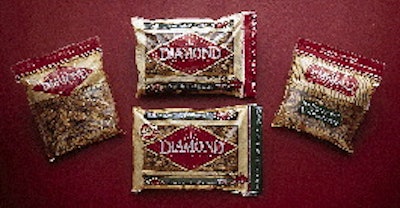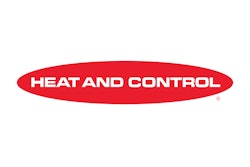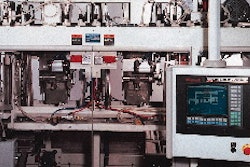Some say it's harder to stay on top than it is to reach the summit. Just ask the Chicago Bulls. Or try Diamond Walnut Growers. The Stockton, CA-based growers cooperative has produced walnuts since 1912. A leader in its product category, the venerable coop last autumn reintroduced its top-selling 14- and 16-oz varieties in new resealable zippered bags. The company's marketing department saw the move as a slam dunk. So far, its foresight has stimulated consumer interest and boosted sales, according to Dennis Bettencourt, Diamond Walnut's senior mechanical engineer. In addition to those sizes, the company recently introduced 200- and 250-g zippered packs sold primarily in select European markets. All four bags are produced on a new line anchored by a horizontal form/fill/seal unit from machine maker/contract packager Robert's Packaging (Battle Creek, MI). Bags are automatically case packed on a modular case erector/packer/closer supplied by Goodman Packaging (Lake Forest, IL). The zipper material, from Presto Products (Appleton, WI), is heat-sealed to film from Plicon (Columbus, GA). "We established an entire packaging line specifically to produce zippered bags, which we didn't have before last fall," says Bettencourt. "Our competitors don't offer that feature. "In the past," Bettencourt continues, "we had an old vertical form/fill/seal machine that we had used for 'conventional' bags. With extensive modifications, that machine was occasionally used to produce zippered bags for test markets, but the zippers were on the vertical dimension. The bags looked like tobacco pouches," he says with a slight grimace. "And those older machines wouldn't have been able to produce the bags at the speeds we wanted." The Robert's C-1000 is rated at speeds to 140 bags/min, though Diamond runs it at around 100/min. That's the same speed its former vf/f/s machine achieved on non-zippered bags. "The speed sold us on the machine," notes Bettencourt. "We looked seriously at other horizontal machines that could apply zippers, but they ran in the 60- or 70-per-minute range." Economical film A powered unwind feeds the Robert's machine. Plicon supplies the 2-mil film used for the most popular bags, which contain 14 and 16 oz of walnuts. Film includes a 48-ga layer of polyester that's reverse-printed flexographically in five colors. That material is adhesive-laminated to a 1.5-mil inner layer of linear low-density polyethylene. The Plicon structure replaces a 1.8-mil adhesive lamination of two layers of oriented polypropylene. The current structure provides improved moisture and oxygen barrier. But a key attribute, says Bettencourt, "is that among the films suitable for zipper application, it was the most economical film we could use." For the 14- and 16-oz bag sizes, the 21"-wide roll of film unwinds through a series of dancer rollers. A Julian date code is stamped onto an area of the film that becomes the back of the bag. The film continues to a plow plate where it's folded in half. Presto Products' Fresh-Trak® zipper enters the folded film from a separate unwind. The zipper is primarily LDPE, though it includes a second coextrudate that promotes faster sealing at lower temperatures. The zipper runs horizontally along the top of the folded film. The zipper's male and female profiles are locked together, with the male profile heat-sealed to one inner side of the film, the female profile heat-sealed to the other inner film side. A stationary "knife" device then opens the zipper for downstream filling as the zipper contacts this knife. Heated sealing jaws then seal the sides of the film at temperatures around 285°F. The two edges of the zipper material are then "crushed" to the same thickness as the film. Chilled water cools the sealed material. Next a knife cuts a small notch into the area of film above the zipper. This notch, along with a printed "tear or cut here," instruction, makes it easy for consumers to open the bag. Draw rollers then pull the film to a cutoff knife. A photoeye reads a registration mark as a guide for accurate cutting within the vertical side-seal area. Once cut from the folded rollstock, the bag is grasped by two clamps, one at each top corner. Clamps swing forward, using a lever that opens and closes to either grasp or release the bag. The Robert's C-1000 includes 42 sets of clamps that hold bags throughout the filling process. These clamps are part of a servo motor-driven assembly that revolves along an oval track. Vacuum cups from opposite sides of the bag pull it open. At the same time, air is blown into the bag to completely open it. The C-1000 fills two bags at a time, through two reciprocating funnels. Fills two at a time Shelled walnuts are delivered to the filling line in metal bins containing between 2괌 and 2귔 lb of product. A hydraulic carriage system lifts the bin about 23' along a frame, then rotates the bin so that product is carefully dumped into a surge hopper. The system is referred to as a hydraulic box dumper by its maker, Meyer Machine (San Antonio, TX). From the surge hopper, walnuts are fed onto a vibratory feeder, then to a dispersion cone that feeds 16 "pool" hoppers (or buckets) that are part of an Ishida RZ-216B double combination scale system from Heat and Control (Hayward, CA). Directly beneath each of these 16 buckets are corresponding weigh and booster hoppers. The 16 sets of three-deep hoppers are positioned in a circle around the dispersion cone, eight feeding each of the two filling funnels. In sequence, pool hoppers release product to the weigh hoppers. The computerized Ishida system weighs walnuts in each weigh hopper, instructing a combination of hoppers that most closely matches the target weight to release product into the reciprocating fill funnels. Each fill funnel receives a charge of product on its backstroke. As it strokes forward, its bottom opens and product is discharged. Each funnel fills roughly 50 bags/min at Diamond Walnut. "The accuracy of our fills has improved considerably since we switched from the vertical form/ fill/seal machinery," says David Baffoni, production supervisor. "At that time, our overfill accuracy was 1.5 grams on a one-pound bag. Now it's one gram per bag." Unusual top sealing Filled bags continue on the Robert's machine to an overfill bag eject station where a proximity sensor mounted above the bag looks down into the bag, measuring the distance to the top of the product. If the fill height is too high, two clamps release the bag into a box below prior to top sealing. Underfills are detected by a downstream checkweigher. Filled bags continue to a "dedusting" station where bag tops are slightly agitated upon contact with flaps that are mounted to a motor-driven belt. This loosens any possible crumbs or walnut dust that might compromise seal integrity. Top heat sealing comes next. Unlike most equipment that seals one bag at a time, the Robert's machine uses a reciprocating unit with three seal bars to clamp and seal three consecutive bags simultaneously. This system is designed for high-speed applications like Diamond Walnut's. For each of the three bags, reciprocating seal bars clamp onto the bags, then release them before retracting to grab the next three. Subsequently, a second reciprocating unit, this one for cooling the top seal, grabs and cools two bags at a time. The two clamps hold each bag throughout top sealing and cooling. Once the reciprocating cooling unit releases two bags, the clamp levers open, releasing bags between two sides of a V-belt conveyor. Compression exerted by the two belts on both sides of the bag closes the male and female zipper profiles. Diamond Walnut believes this step provides added product protection. Bags are then conveyed on a 90° angle to a metal detector/ checkweigher system. This system was integrated by Prototype onto a custom infeed conveyor that delivers bags to its model B-EDHCG modular case erector/packer/closer. Robotic pick-and-place A photoeye on the infeed conveyor detects the presence of an incoming bag. At the end of the infeed conveyor is an approximately 2'-long oscillating product diverter plate section. The plate remains in the down position to allow one bag to be conveyed across it to the second layer forming conveyor. The plate raises to allow the next bag to drop onto the first layer forming conveyor. Bags alternate from one layer forming conveyor to the other to accommodate the 100 bpm output of the hf/f/s machine. The two layer forming conveyors are positioned on a right angle to the single infeed conveyor. One servo-controlled robotic loading head is used to pick bags from each layer forming conveyor. Each head is equipped with suction cups that lift two bags at a time and transfer them into awaiting cases on a conveyor below. Corrugated case blanks are pulled from a magazine by vacuum and opened. The case opener transfers the squared case to a bottom closer that applies hot melt to seal the bottom. A compression platen positioned above descends into the case to create a solid bond. The robotic heads pick-and-place bags of walnuts in pack patterns that vary depending on bag size. For 1-lb bags, each box holds six layers, each comprising two (12-count) or four bags (24-count). With the 24-count case, the first three layers of four are placed at the first lane, and with the first robotic head. The next three layers of four are placed by the second lane/head. The 200- and 250-g bags are packed in 10 layers, two bags/layer. Packed cases are conveyed to a top-seal module where hot melt is applied to the outside of the folded-in minor flaps. Majors are plowed down onto the minors with compression plates used to create the bond. Cases then index out of the Prototype equipment via a discharge conveyor. Case coding and manual palletization follow. Pallet loads are then forklifted to stretch wrapping equipment and staged for distribution. "The Prototype unit replaced a drop packer that we had used previously," notes Jim Puckett, maintenance supervisor. "We had problems with it in that if it didn't drop bags perfectly, the machine would shut down and we'd have to make adjustments, then start it up again. It didn't do a good job positioning bags in layers within the case, so we had some downtime." Bettencourt adds, "The Prototype units have reduced our downtime by a good 15 percent." Soon Diamond Walnut will be entering its busy holiday season. The 2ꯠ-member cooperative grows all its own walnuts in California's Central Valley, packaging them all on 14 lines at its 520ꯠ sq' Stockton plant. The harvest season runs from early September to mid-November. Justification The zippered bag line, Diamond's newest, is expected to provide payback in 33/4 years. "Right now, the zippered bag line is used for between five and six million pounds of walnuts in one-pound sizes, and 750ꯠ pounds for the 14-ounce bag. It's too early to tell volume on the smaller export sizes. However, demand for resealable packaging is growing dramatically in many key overseas markets." Exports, Bettencourt notes, account for about 30% of Stockton's shelled walnut sales. Domestically, shelled walnuts account for approximately 80% of sales. Beyond its own production, Diamond Walnut envisions using the zippered bag line to contract package other dry, flowable products. "Right now, our plant does about $2.5 million a year in contract packaging. We plan to double that in the next three years as a result of adding this new equipment." In the future, Diamond Walnut's two smaller bag sizes could be sold in a stand-up pouch, since the Robert's equipment is capable of forming, filling and sealing such pouches.

































